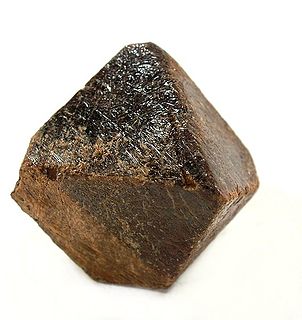
Dysprosium is a chemical element with the symbol Dy and atomic number 66. It is a rare-earth element with a metallic silver luster. Dysprosium is never found in nature as a free element, though it is found in various minerals, such as xenotime. Naturally occurring dysprosium is composed of seven isotopes, the most abundant of which is 164Dy.

Paul Adrien Maurice Dirac was an English theoretical physicist who is regarded as one of the most significant physicists of the 20th century.

Pyrochlore (Na,Ca)2Nb2O6(OH,F) is a mineral group of the niobium end member of the pyrochlore supergroup. The general formula, A2B2O7 (where A and B are metals), represent a family of phases isostructural to the mineral pyrochlore. Pyrochlores are an important class of materials in diverse technological applications such as luminescence, ionic conductivity, nuclear waste immobilization, high temperature thermal barrier coatings, automobile exhaust gas control, catalysts, solid oxide fuel cell, ionic/electrical conductors etc.

In particle physics, a magnetic monopole is a hypothetical elementary particle that is an isolated magnet with only one magnetic pole. A magnetic monopole would have a net "magnetic charge". Modern interest in the concept stems from particle theories, notably the grand unified and superstring theories, which predict their existence.
Magnetostriction is a property of magnetic materials that causes them to change their shape or dimensions during the process of magnetization. The variation of materials' magnetization due to the applied magnetic field changes the magnetostrictive strain until reaching its saturation value, λ. The effect was first identified in 1842 by James Joule when observing a sample of iron.

The magnetic moment is the magnetic strength and orientation of a magnet or other object that produces a magnetic field. Examples of objects that have magnetic moments include: loops of electric current, permanent magnets, elementary particles, various molecules, and many astronomical objects.

Dysprosium(III) chloride (DyCl3), also known as dysprosium trichloride, is a compound of dysprosium and chlorine. It is a white to yellow solid which rapidly absorbs water on exposure to moist air to form a hexahydrate, DyCl3·6H2O. Simple rapid heating of the hydrate causes partial hydrolysis to an oxychloride, DyOCl.
A single-molecule magnet (SMM) is a metal-organic compound that has superparamagnetic behavior below a certain blocking temperature at the molecular scale. In this temperature range, a SMM exhibits magnetic hysteresis of purely molecular origin. In contrast to conventional bulk magnets and molecule-based magnets, collective long-range magnetic ordering of magnetic moments is not necessary.

Montonen–Olive duality or electric–magnetic duality is the oldest known example of strong–weak duality or S-duality according to current terminology. It generalizes the electro-magnetic symmetry of Maxwell's equations by stating that magnetic monopoles, which are usually viewed as emergent quasiparticles that are "composite", can in fact be viewed as "elementary" quantized particles with electrons playing the reverse role of "composite" topological solitons; the viewpoints are equivalent and the situation dependent on the duality. It was later proven to hold true when dealing with a N = 4 supersymmetric Yang–Mills theory. It is named after Finnish physicist Claus Montonen and British physicist David Olive after they proposed the idea in their academic paper Magnetic monopoles as gauge particles? where they state:
There should be two "dual equivalent" field formulations of the same theory in which electric (Noether) and magnetic (topological) quantum numbers exchange roles.

A spin ice is a magnetic substance that does not have a single minimal-energy state. It has magnetic moments (i.e. "spin") as elementary degrees of freedom which are subject to frustrated interactions. By their nature, these interactions prevent the moments from exhibiting a periodic pattern in their orientation down to a temperature much below the energy scale set by the said interactions. Spin ices show low-temperature properties, residual entropy in particular, closely related to those of common crystalline water ice. The most prominent compounds with such properties are dysprosium titanate (Dy2Ti2O7) and holmium titanate (Ho2Ti2O7). The orientation of the magnetic moments in spin ice resembles the positional organization of hydrogen atoms (more accurately, ionized hydrogen, or protons) in conventional water ice (see figure 1).
Helimagnetism is a form of magnetic ordering where spins of neighbouring magnetic moments arrange themselves in a spiral or helical pattern, with a characteristic turn angle of somewhere between 0 and 180 degrees. It results from the competition between ferromagnetic and antiferromagnetic exchange interactions. It is possible to view ferromagnetism and antiferromagnetism as helimagnetic structures with characteristic turn angles of 0 and 180 degrees respectively. Helimagnetic order breaks spatial inversion symmetry, as it can be either left-handed or right-handed in nature.
Spin-polarized scanning tunneling microscopy (SP-STM) is a type of scanning tunneling microscope (STM) that can provide detailed information of magnetic phenomena on the single-atom scale additional to the atomic topography gained with STM. SP-STM opened a novel approach to static and dynamic magnetic processes as precise investigations of domain walls in ferromagnetic and antiferromagnetic systems, as well as thermal and current-induced switching of nanomagnetic particles.

Dysprosium titanate (Dy2Ti2O7) is an inorganic compound, a ceramic of the titanate family, with pyrochlore structure.
An orthoferrite is any of a class of chemical compounds with the formula RFeO3, where R is one or more rare-earth elements. Orthoferrites have an orthorhombic crystal structure with a space group Pbnm and most are weakly ferromagnetic. At the Néel temperature the subsystem of iron ions orders into a slightly canted antiferromagnetic structure with antiferromagnetic moment G and a weak ferromagnetic moment F. The rare-earth ion subsystem acquires magnetization m due to an interaction with the iron subsystem.
In quantum mechanics, fractionalization is the phenomenon whereby the quasiparticles of a system cannot be constructed as combinations of its elementary constituents. One of the earliest and most prominent examples is the fractional quantum Hall effect, where the constituent particles are electrons but the quasiparticles carry fractions of the electron charge. Fractionalization can be understood as deconfinement of quasiparticles that together are viewed as comprising the elementary constituents. In the case of spin–charge separation, for example, the electron can be viewed as a bound state of a 'spinon' and a 'chargon', which under certain conditions can become free to move separately.

Steven T. Bramwell is a British physicist and chemist who works at the London Centre for Nanotechnology and the Department of Physics and Astronomy, University College London. He is known for his experimental discovery of spin ice with M. J. Harris and his calculation of a critical exponent observed in two-dimensional magnets with P. C. W. Holdsworth. A probability distribution for global quantities in complex systems, the "Bramwell-Holdsworth-Pinton (BHP) distribution", is named after him.

In theoretical physics, the dual photon is a hypothetical elementary particle that is a dual of the photon under electric–magnetic duality which is predicted by some theoretical models, including M-theory.

Holmium titanate is an inorganic compound with the chemical formula Ho2Ti2O7.

Laura Jane Heyderman, is a physicist, materials scientist, academic and Professor of Mesoscopic Systems at the Department of Materials, ETH Zurich and Paul Scherrer Institute. Her research is focused on magnetism and magnetic materials.
Nicholas Frederick Chilton is an Australian chemist and a Senior Lecturer in the Department of Chemistry at the University of Manchester. His research is based on magnetochemistry and computational chemistry, including on the design of high-temperature single molecule magnets, design of molecular spin qubits for quantum information and in developing methods and tools for modelling magnetic calculations.











